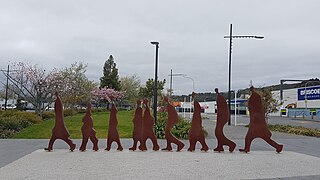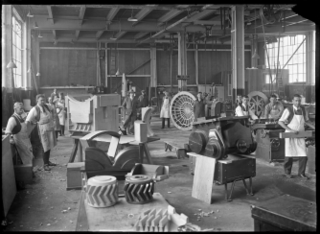
Silverstream is a suburb of Upper Hutt in New Zealand, just under 7 km south-west of the Upper Hutt CBD. It is in the lower (southern) part of the North Island of New Zealand at the southern end of Upper Hutt, close to the Taitā Gorge, which separates Upper Hutt from Lower Hutt. The area is sited at the mouth of a small valley formed by the Wellington Region's tectonic activity and, in part, by Hull's Creek, which discharges into the Hutt River.
Te Mārua is the easternmost urban suburb of Upper Hutt. For reasons of location and distance from the city, the area is often classified as rural. Te Mārua is well known for its Plateau Reserve where remnants of the old Rimutaka Railway path can be found, which now form part of a historic walk. Mt Climie, the highest peak of the Remutaka Range, can also be reached from the reserve. The suburb is also the location of the Wellington Speedway, a nationally important venue for stock car racing, and of the Wellington Naturist Club's club grounds, venue of the historic 2016 World Congress of the International Naturist Federation.
Alicetown is a central suburb of Lower Hutt located at the bottom of the North Island of New Zealand.

Belmont, a suburb of Lower Hutt, to the north of Wellington in the North Island of New Zealand, lies on the west bank of the Hutt River, on State Highway 2, the Wellington-Hutt main road, and across the river from the centre of Lower Hutt.
Heretaunga is a suburb of the city of Upper Hutt, located in the lower (southern) North Island of New Zealand. The settlement, one of the older suburbs in the Hutt Valley, dates from the 1840s when European settlers sought country sections. A prime example of a "leafy" suburb, Heretaunga includes quiet tree-lined streets. It is characterised by large houses, often Edwardian or from the mid-20th century.

Tōtara Park is a suburb of Upper Hutt, New Zealand, located 2 km northeast of the city centre. It is accessed via the Tōtara Park Bridge which crosses the Hutt River, connecting it to State Highway 2 and the main Upper Hutt urban area. It was popular in the 1970s and 1980s for families moving into the Upper Hutt area.
Elderslea is a suburb of Upper Hutt located in the lower North Island of New Zealand, near Upper Hutt Central.
Ebdentown, a suburb of Upper Hutt located in the lower North Island of New Zealand, near Upper Hutt Central.

Upper Hutt Central is the commercial and geographic focal point of Upper Hutt city, located in the lower North Island of New Zealand.
Clouston Park is a suburb of Upper Hutt, located 0.5 – 2.5 km east-northeast from the city centre. It was predominantly developed in the 1970s and 1980s. While the suburb is predominantly flat, there are a few larger homes situated on the lower slopes of the Eastern Hutt Valley Hills that offer wide views of the Upper Hutt Valley.
Maoribank is a suburb of Upper Hutt, located 2–3 km east-northeast of the city centre. It was predominantly developed between 1950-1970 and had a population of just less than 1000 at the 2013 Census.
Brown Owl is a suburb of Upper Hutt, located 3–4km from the city centre. It developed slowly from the 1960s
Boulcott is a central suburb of Lower Hutt City situated in the south of the North Island of New Zealand. The suburb lies about a kilometre north-east of the Lower Hutt CBD.
Tirohanga is a suburb of Lower Hutt City situated at the bottom of the North Island of New Zealand. The suburb is located on the western side of the Hutt River and State Highway 2.
Manor Park, a northern suburb of Lower Hutt City, lies in the south of the North Island of New Zealand. The suburb separates the western bank of the Hutt River from State Highway 2.

Woburn is a suburb of Lower Hutt, Wellington situated at the bottom of the North Island of New Zealand.

Waiwhetū is an eastern suburb of Lower Hutt in the Wellington Region situated in the south of the North Island of New Zealand.
Maungaraki is a suburb of Lower Hutt City situated at the bottom of the North Island of New Zealand. The suburb is located on the western hills of the Hutt Valley with access to the area via State Highway 2 and offers extensive views of Wellington harbour and Matiu/Somes Island. It contains the largest suburban development on the Hutt Valley's western escarpment that runs along the Wellington Fault.
Gracefield is an industrial suburb of Lower Hutt City, located at the bottom of the North Island of New Zealand.

Korokoro, a suburb of Lower Hutt City, lies in the south of the North Island of New Zealand. The suburb occupies part of the western hills of the Hutt Valley; its eastern slopes overlook Petone and the Wellington harbour.







